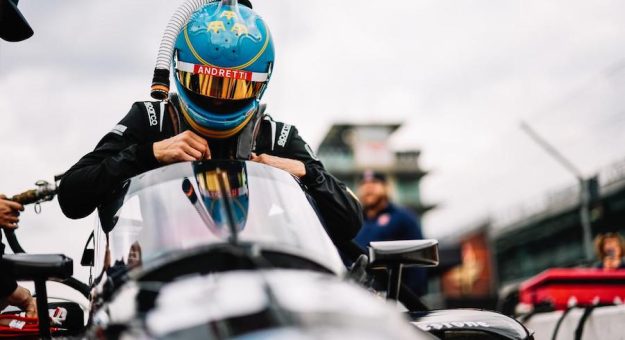IndyCar and its partners have come up with a paddle system to regenerate the unit on ovals. The energy is regenerated and stored by using the brakes on street and road courses, but brakes are rarely used on ovals.
On a superspeedway such as the 2.5-mile Indianapolis Motor Speedway, the intention is to only use the brakes on pit stops. To meet that challenge, the driver can recharge the system by using a paddle on the steering wheel or a button.
“We had paddles on the car already,” Niles said. “Using that for regen seemed like the natural thing to do. We had to do some software trickery to reassign the clutch paddle for use while out on track.
“But it seems like it could work, and that’s what we’re trying to figure out here today and tomorrow, is get the drivers out there together and see if we could get it to work in a pack.”

Buckner explained why the paddle system was the best way to regenerate the system.
“When we were looking at how we could make this work on a superspeedway, the paddle was a fit for how the drivers could manage the energy in the system, out of the system,” Buckner said. “It kind of plays into the hands of the driver with how this place historically races. It seemed like a good starting point for first couple days here.
“I think we’re all learning a lot. There are a lot of details to come on that, but all good so far.”
It will give the drivers one more tool to use during the races.
“I think it’s exciting for the series. It’s a really cool new feature that we’re going to have,” said 2022 Indianapolis 500 winner Ericsson, now with Andretti Global. “I’m hoping it’s going to be a way where you can as a driver be smarter than your competitors and do it better than your competitors. That excites me with the whole system.
“As it seems, it’s going to be quite manual. I think that will be really cool.
“I have some experience from F-1 when we introduced that. It was my first year in Formula 1 when they introduced the hybrid there. It reminds me a bit of those days where you sort of try different things. It’s a bit of an experiment.”
Two-time NTT IndyCar Series champion Palou of Chip Ganassi Racing has been active in hybrid-assist testing.
“At Barber, for instance, the balance felt different,” Palou said. “It felt a bit tougher. The steering wheel was really heavy. Josef Newgarden said the same thing.
“At Indianapolis, if you’re not using it, you don’t even know if you have that added weight or stuff like that. So, it didn’t change.
 “The only issue is when you recharge in clean air, you lose a lot of speed. You gain it back. If I recharge here, I’m losing a ton, then I gain it back there.
“The only issue is when you recharge in clean air, you lose a lot of speed. You gain it back. If I recharge here, I’m losing a ton, then I gain it back there.
“When you are in traffic, we normally start let’s say coasting at the start/finish line, I think it’s a moment which you recharge and hopefully if you’re in third you can still overtake.
“We need to see in traffic it might change. I think it’s actually going to be better here than in other places.”
The hybrid-assist system includes a unique concept of using super capacitors to store energy instead of a battery. There is an electric motor that produces the power in concert with the internal combustion, fuel-powered engine. By using low voltage capacitors, it will be easier to power down the electrical charge — important to safety workers as they tend to disabled race cars.
The entire unit fits into the bell housing of the car.
“It’s got a lot of horsepower, low voltage,” IndyCar President Jay Frye said. “That was something that was important. How that works without batteries or cap backs. High horsepower, all this fits inside the bell housing.
“Obviously, the packaging on an Indy car has to be small. One of the biggest challenges is the packaging of it into this car.”
The energy storage and electric motor are tied into the drivetrain of the vehicle.
On an oval, the driver uses a paddle or a button to store energy and add power to the car. The system can be used with either automatic regeneration or the driver pulling on the paddle.
“It’s going to give the drivers a new toy, a new tool,” Frye said. “Some of them are going to like it probably more than others, it’s going to be interesting to see how it plays out.”
IndyCar owner Roger Penske is confident both Chevrolet and Honda will meet the challenge on the hybrid-assist project.
“We’ve been working on this for many, many months,” Penske said. “The cooperation between Chevrolet and Honda has been terrific. We are in the testing stage now and we have run hundreds of miles through the system. We are getting the different teams to test it and get mileage from it. It’s going to be durability and the ability to build enough units by the time we start the season.
“Right now, we are on schedule. We have to meet certain gates and hurdles to get through.”
This story appeared in the Nov 15, 2023 edition of the SPEED SPORT Insider.

